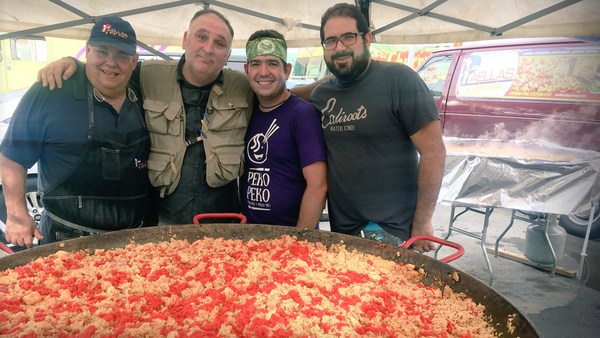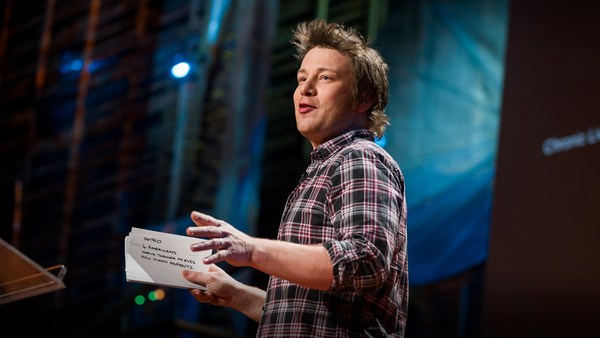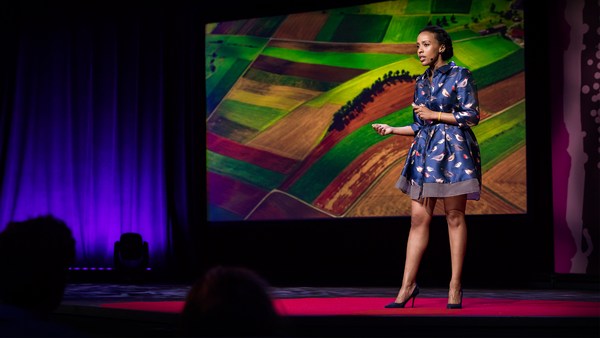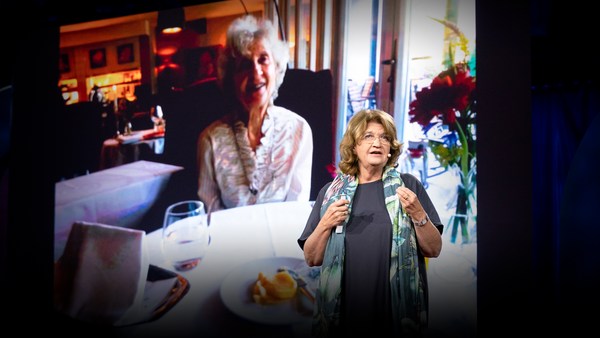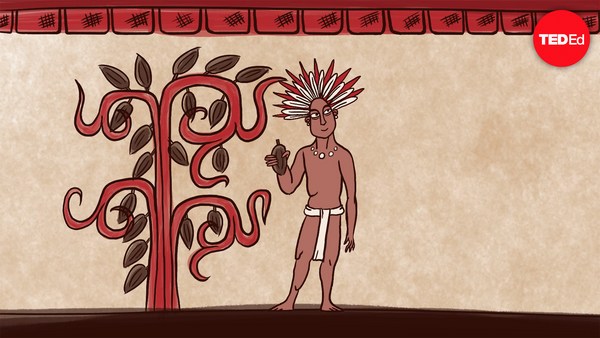We're living in difficult times because, on one hand, thanks to connectivity, we can see the most beautiful sides of humanity but, on the other hand, also the ugliest: hunger, violence, war, hatred, intolerance; daily scenes that, when we come home at the end of the day, we feel that everything is kind of lost.
But it's not, because it's precisely at home where we might find one of the most infallible tools to fight for the nutritional, emotional and environmental well-being of our planet. Where at home? Well, in the kitchen. I'll tell you why with three stories.
The first one: I'm from Lima, a product of mixed bloods, as you can see: my mother, a daughter of the coastal area, aristocratic and viceregal, and my father, a son of the Andes, the Incas, from Cuzco. So in my home, the Andes and the coastal area, which are historically confrontational, ended up together because of love, as happened to most people from Lima, descendants of diverse backgrounds: Africans with people from the Amazons, Japanese with Andeans, Chinese with Italians.
Like this love story, for example: the daughter of a prosperous Cantonese store owner fell in love playing on the streets of the port of Callao in Lima with the son of a famous Genovese pastry chef from Italy. In the beginning, their parents were totally against their love, so they decided to run away to create their home. It's there that they discover their biggest differences. Where? On the table. She discovers that she really loved the fried rice that her father used to make for her in the wok. And he loved his grandmother's slow-cooked risotto. She wanted to add soy sauce to everything.
(Laughter)
And he wanted to add Parmesan cheese to everything.
(Laughter)
In the end, they come to an agreement: They cook their rice in the wok, but they slow cook it.
(Laughter)
They add a little bit of Parmesan cheese and a little bit of soy sauce. And a new dish is born: the Peruvian rice with seafood, which has a little bit from one, and a little bit from the other -- like all the dishes in our cuisine with that magical seal of a Peru that, for many centuries, received millions of people who had the dream of building their lives in our country. They were not received in ghettos or separated, but integrated, joined together, and, at least in the kitchen, learned to build bountiful bridges of love and peace. The message from Peru is clear: nothing bad can happen to us; only good things will occur when we embrace our diversity.
The second story is about me, a chef. I started my training in Paris, as a student, where I also had the good fortune of meeting my wife, Astrid, who I convinced to come to Peru, to make our dream come true: a small restaurant, a nice restaurant that would support our family. This was our first restaurant: Astrid and Gastón. This was the 90s, and during the 90s -- as was happening with cuisines across most of the world -- we were living under the influence of the French haute cuisine, in a world where the local public would also always prefer anything that came from abroad, rather than from our own land. Maybe that's the reason why when we came home, even though we had a lot of customers every day, we didn't feel fulfilled.
We'd hear that little voice saying: "Does it make sense to have a French restaurant, run by a German and a Peruvian, in a city that is not in France, but in Peru?"
(Laughter)
The answer would come years later, at the beginning of this century, when two important events took place. First, the world was becoming connected through internet. As a result, countries started to value the diversity of their people, and Peru was one of them. Second, the Peruvian economy began to experience a steady growth after the defeat of the Shining Path. It was the perfect timing for my generation of cooks and chefs to begin to work together; to move past egos, vanities and distrust, and to remove any competition between us in order to work for those who didn't have a voice: the cooks in the corners, the cooks in the markets, the small farmers in the Amazon, in the Andes, on the coast, the artisanal fishermen on the Pacific -- all historically forgotten or underappreciated. Thanks to this movement, we began to envision an opportunity to build a space of mutual trust, an environment of trust that would allow us to work toward collective goals that were much more important and transcendental. Thanks to this movement, we started to imagine a Peruvian cuisine that would bring a new message of a magical and seductive Peru to the world, with Peruvian restaurants that spread all over the world transformed into vibrant embassies promoting our culture and our products every day and convincing the world's tourists to come and visit Peru.
In the beginning, as it usually happens, they thought we were crazy utopians. "Ceviche? As important as a French dish?"
(Laughter)
"Using our cooking, an insignificant and day-to-day event, as a tool to promote the image of our country to the world, or as a key to unify a nation?"
"No, that's impossible," they'd say.
But, it happened. Today, the Peruvian cuisine is in people's hearts all over the world. Thanks to that, something very important happened -- even more important than the presence of ceviche today on menus of famous restaurants in Paris; or that Peruvian cuisine is now, without doubt, at the same level as those other great cuisines of the world; or that Lima has become a hotspot for tourists thanks to the virtues of its gastronomy, creating opportunities and jobs for many people.
The most important thing that we achieved was to build a deep sense of confidence and belief in our identity, and a space of union amongst Peruvians that moves us when we see our cuisine recognized around the world. It's true that for a long time, we were told that it'd be better if we denied our origins -- that to be valued, we must act like Europeans or Americans. As a result, full of fear, we hid this love from our parents, to protect it. But finally, today we can celebrate proudly, with confidence and in peace, our multicultural identity. The message in this second story also emphasizes the idea that cooking can be a tool for happiness and well-being if we embrace our multicultural identity.
The third story does not bring very good news. From the Industrial Revolution until now, we have been forced into a lifestyle that prompts us to consume products we don't really need. Products that are also cut off from the rational use of our ingredients and environment -- but that marketing campaigns have led us to believe we couldn't happily live without them. Today, for example, this has culminated in more people dying due to obesity than due to hunger. In developed cities, more people die by suicide than by crime. In the case of Peru, despite a growing economy, there's malnutrition and anemia in places that export their own food, while the Amazon and our seas are being destroyed and overfished. Here is where cooking can help us again -- not just in Peru, but all over the world. How? By placing cooking at the heart of our homes, at the center of everything, with information and education. Because with information and education, we can make the right decisions about what to cook and what to eat so we can find a new balance, in which we can all live in harmony. A new harmony between health and enjoyment, between small producers and the big industries, between the local culture and the environment, between local products and universal products. That's precisely the reason why we have to place cooking at the heart of our homes. Because if we take this message to every home, if cooking becomes important again in each home, the effects in the market and in many other activities would be massive and powerful.
Maybe some are thinking the same thing as those other people who thought that Peruvian cuisine would never be in the hearts of people around the world. I can imagine them thinking: How can we relay to the public a message explaining that a balanced meal cooked in their home kitchen is the best tool to fight inequality and disease and to help save the environment? How can we convince politicians to write global public policies following this idea? It looks impossible. How can we achieve this? To be honest, we don't know.
(Laughter)
That's the reason why, for a long time, chefs from around the world have been working together, each of us in our own field, to reach the goal of spreading this message -- and not waiting for the governments. For example, here in New York, Dan Barber, in his Blue Hill, very close to New York City, has been fighting for a long time to show that a diverse and sustainable agriculture can produce food and products of high quality at a massive scale for all families -- and they can be delicious, accessible, healthy, friendly and sustainable. Or in France, the great chef Alain Ducasse in his Hôtel Plaza Athénée, on Avenue Montaigne, the most luxurious of Paris, decided to remove meat from his menu without fearing that his sometimes capricious clients might leave -- because he's aware of the negative impact that excessive meat consumption has on the environment and is convinced that by sending a coherent discourse from his restaurant, his message can reach many more homes. Or in Peru, Pedro Miguel Schiaffino, a great chef and a good friend, who goes to the farthest corner of the Amazon looking for ingredients, traditions and craftsmanship, because he believes that by bringing them back to his restaurant he can convince the 10 million inhabitants of Lima that using these products will bring prosperity to these communities, while also showing respect and giving value to their cultural identity.
All over the world, chefs are joining forces thanks to their cooking, just like our parents joined at the table because of their love. Just as it happened with that generation of chefs in Peru that one day decided to work together to promote their culture. Just as it's happening now. We're convinced that we can't wait for others to do it. So we've decided to act, because thanks to the media and the popularity of the professional kitchen in the world today, as chefs, we know that we can do a lot to help spread this message of placing cooking at the center of our home. In this way, sometime in the near future, each and every family, home and person with good information can pick ingredients that will help to recuperate our health and environment, to fight inequality, and moreover, to recover that emotional peace that we need.
This is the power of cooking, one of the most infallible tools to achieve our well-being.
Thank you.
(Applause)
